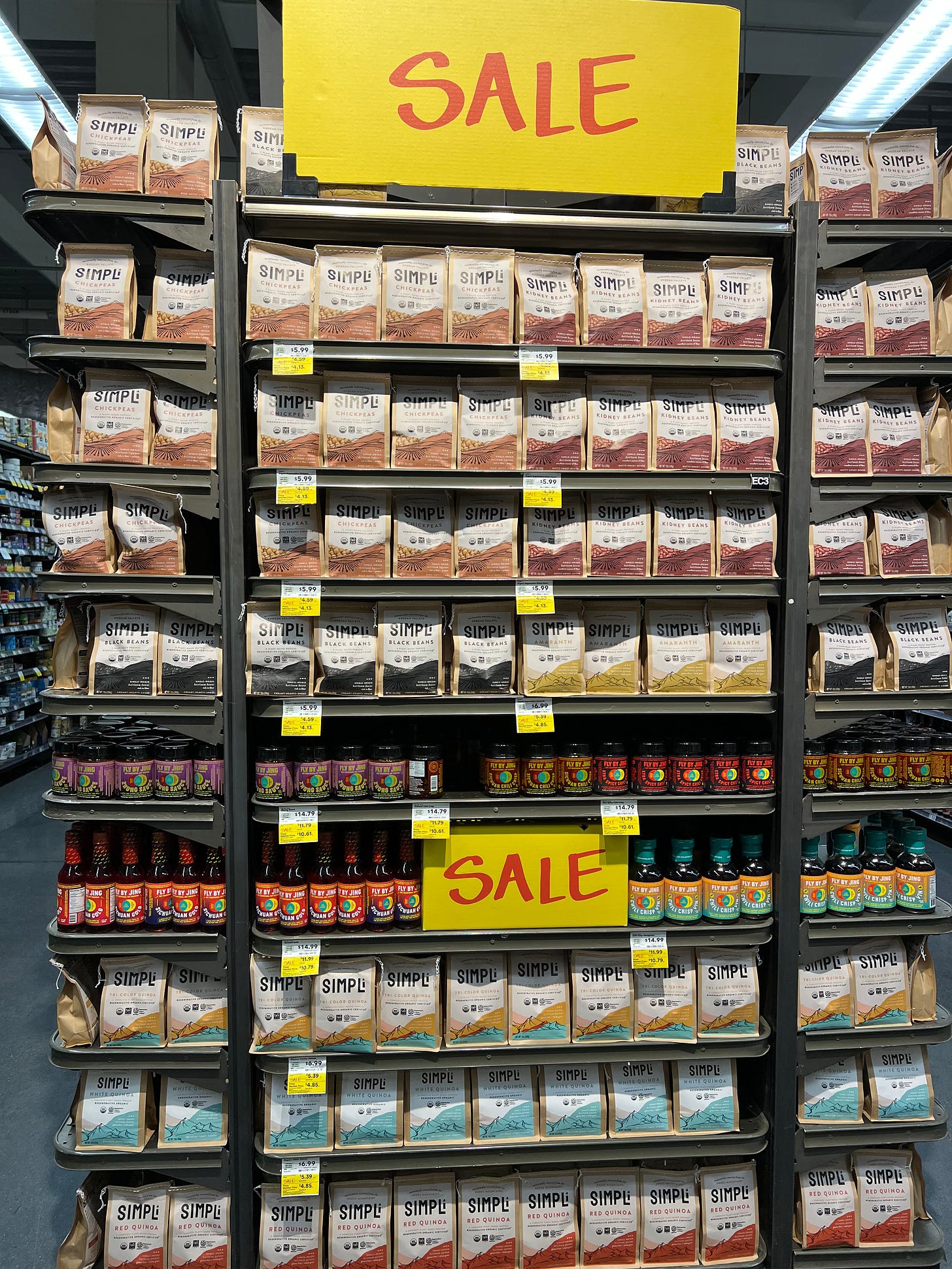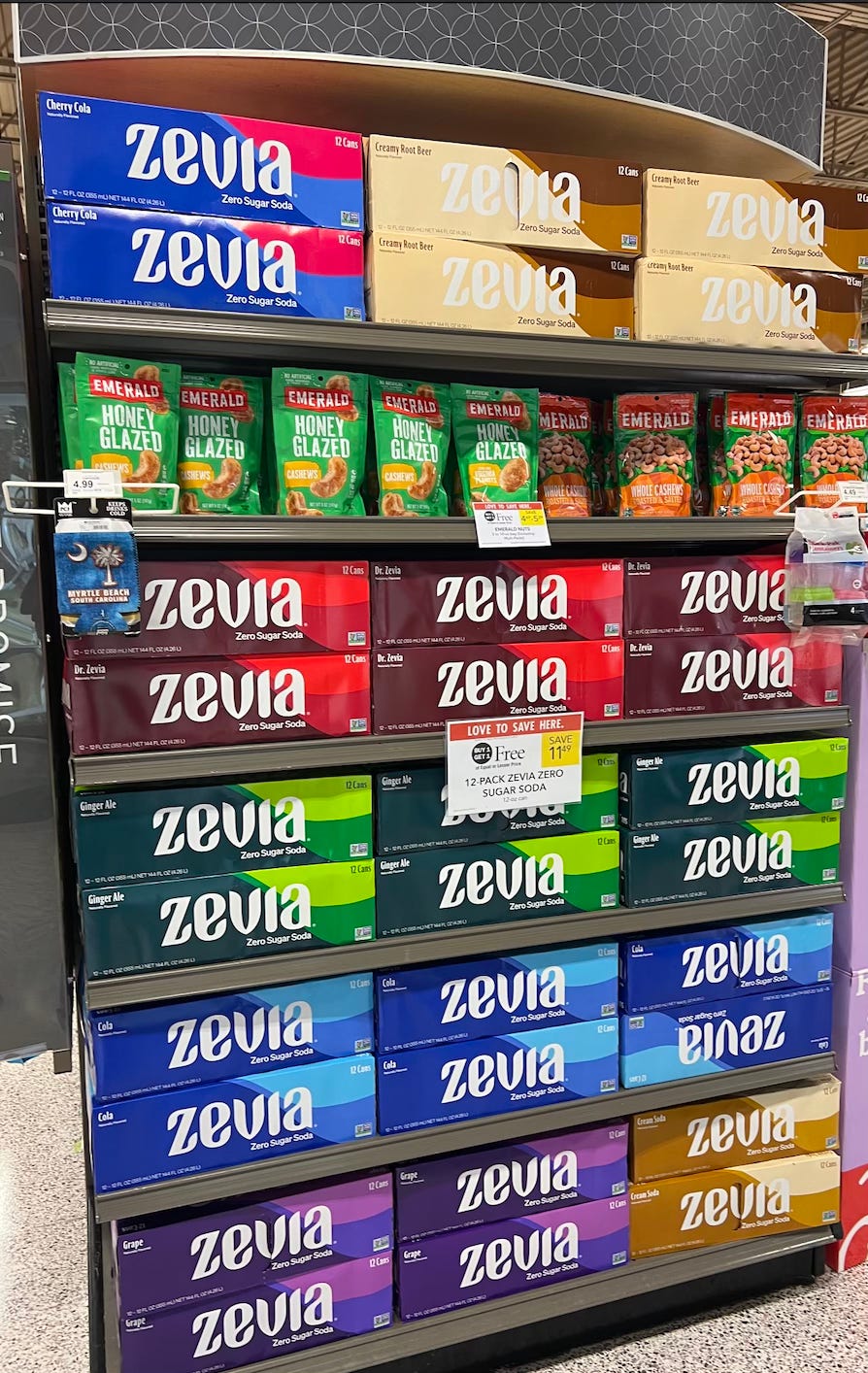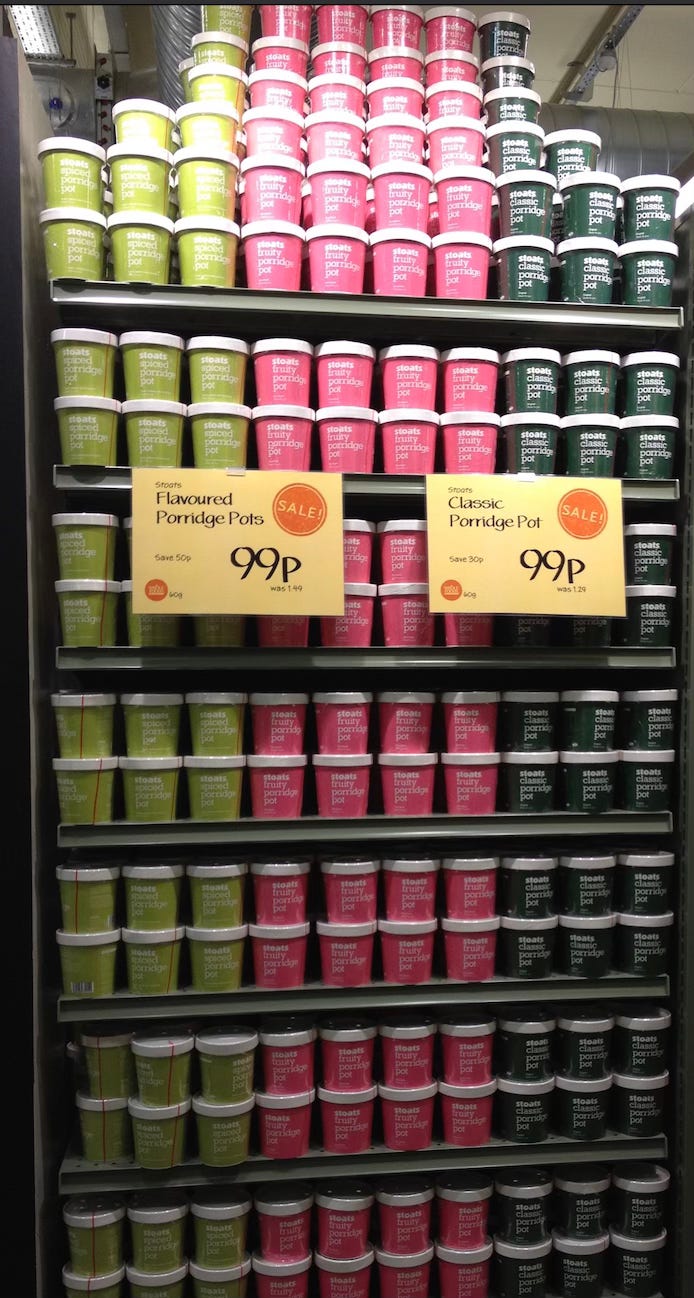Welcome back to The Checkout Grocery Update. We are one year old as of this week. Since this is now our second year in existence, we are starting over at #1.
If you want to know what we were up to for the last 365 or so days, here are some of our faves. If you want to know what our priorities are and why we continue to focus on a certain set of issues and don’t pay much mind to the latest BS trends, see here.
We published around 70 such updates in the last 52 weeks and hope to keep up the pace for the next 52 weeks. We appreciate our sponsor, the non-profit Specialty Food Association, and we appreciate all of our subscribers who have stepped up to support us and tune in regularly. We had nearly 50,000 views in the last month and hope to continue to be worth your time, and if you are paid subscriber, your hard earned money. Thank you!
This week’s piece is a pretty personal rumination on grocery operations. We hope to help readers understand the grocery business better and make it seem as interesting and bonkers as the food service world of The Bear or Anthony Bourdain’s writing, but without harping on the trauma porn and substance abuse as much (we’d rather focus on the economics). This piece below is dedicated to the regional team and store stock crews at the truly bonkers Lamar store 2005-2006, wherever they are now, including Lisa G, Dave P, Wes, Chris P, George, Jason, Kimberly, Adam M, Alex G, Beth, Aaron, Ted F, Roy, Nay-nay, Kevin C, Kevin M, Craig M, Ed P, Jared, Scott P, Rick V, and especially Matty J (who once called us all a bunch of “grocery nerds” and it stuck) as well as the stock crew at the old Florida Plantation store on Peters Road that no longer exists, including Glen, Cliff, Caleb, Anson, Jeherome, Maria B and of course, Howard.
How To Build An Endcap.
By Errol Schweizer
Endcaps are a major feature of grocery stores. You see them all the time, when you walk in, while you are shopping, when you are checking out, when you are trying to leave. They are displays built on the ends of aisles featuring products that are on sale, seasonally appropriate or otherwise being highlighted by the retail staff. They are meant to be eye catching, abundant and tempting, and are a major feature of the retail experience.
Building endcaps is skilled work. It is learned and perfected. It is hard work, but it is also rewarding and even fulfilling, in terms of the brawn and brain required to do it well. Ben Shapiro has never built an endcap, that should be obvious. Anthony Bourdain (RIP) could have built them well, if his talents had not been wasted as a chef (he was a much better writer).
Visual merchandising is a skill as old as civilization itself, going back to the bazaars of the ancient world and the traders hawking their wares in Sumeria, Persepolis, Xi’an, Cahokia. Merchandising is not capitalism. It is work, but capitalism is nothing without the skills of merchandisers. Endcaps are a major feature of retail under capitalism, but they don’t build themselves.
And consistent with the thesis that everything I needed to know I learned as a grocery clerk, building endcaps also offers a window into how our food system works, as well as some good life lessons.
An endcap should be planned ahead.
Endcaps can be spontaneous, but in general, it makes more sense to plan the endcaps well in advance. You need to forecast and order an accurate amount of inventory, during the correct timeframe when there is a discount buy-in window from your wholesaler. This will enable you to put the products on sale by passing the supplier-funded discount through to your customers during the same timeframe. Retail math means that when you get a one dollar discount at wholesale, and then you apply your retail markup and pass that one dollar along to your customers, you probably make a higher gross margin on sale than at regular price. It’s a win/win/win, you pad your gross margins (but not necessarily your profit margins, depending on your shrink and overall assortment blend) and have some job security, while you, your wholesaler and the supplier sells more product, and your customer saves some money on something they love or buys a product on impulse that they otherwise wouldn’t have. Impulse buys are big business in grocery stores, not always for the healthiest products. Those supplier ad dollars are heavily weighted towards high turn, consumable and ultra processed foods, but plenty of better stuff also ends up on endcaps, too.
There is no free market in endcap building, Milton Friedman has left the building. Sure, you can be spontaneous once in a while, if you have excess inventory or if someone else further upstream in the supply chain ordered enough product to support your spur of the moment display. Product does not just magically appear. It must be forecasted, sometimes allocated by corporate buyers, as well as produced, ordered, stocked by your supplier and wholesaler, and shipped to you in an agreed upon timeframe with the negotiated discount.
But lack of planning can mean that you order more than your forecasted allocation for your stores and your wholesaler goes out of stock, because they are usually ordering at just in time inventory rhythms that don’t handle disruptions well and your fellow stores (and competitors) will then go out of stock on this item while you temporarily hoard the inventory until the wholesaler replenishes their stock level. Overall, it is a shitty thing to do, even if your store manager tells you to do so. Endcaps should be planned ahead.
You also need to plan how many skus or product lines will be on the endcap, and how many cases of each you can pack out onto the display. You also need to make sure you have the endcap space available, by selling down on the previous product, transferring inventory to their spots on the shelf and making sure you do not generate too much backstock, but enough to sell this leftover discounted inventory at regular price and skim some additional gross margin (once again, great for job security). These sort of practices help sustain smaller retailers who don’t have the efficiencies and purchasing power of massive scale to bully suppliers and sell products at low margins, sometimes adding five or ten points of margin to the operating model every quarter. Endcap sell down and this forward buying at retail is quite material.
You also need to figure out how many shelves you will need. This simple practice will make or break your endcap. Not enough shelves? Your endcap will look terrible or may not even get built, which brings us to our next life lesson in endcap building. And the final, and most important step in endcap planning, is deciding what endcap spots in the stores get what products and how this squares with seasonality, display space requirements, product sales promotional forecasts or centrally planned inventory allocations, aka, “force-outs” (this happens quite a lot, too,and don’t always ask for store level input, sometimes even generated by AI these days), flyer or digital ad placements, hottest price points, store traffic flow, store leadership preferences, requirements from corporate buyers on what needs to go where based on plannograms, category captain or slotting fee requirements, etc. etc. Planning is key to survival and success.
And endcaps should be well designed and easy to shop. Form follows function.
While you are planning your endcap, you have to think of what skus from the product line will go on it and what they can be cross-merchandised with. Salsa with chips, protein powder and protein bars, eggs and bacon, yogurt and granola, pasta with sauce or pesto, cereal with almond milk, soda with a glucose monitor and insulin shot, etc.
Your main feature item, usually your larger sized or more competitively priced product, will take up most of the space and the cross-merch’d stuff will be slotted in artfully. Usually two product lines are the maximum you should attempt, but sometimes, like during holidays with baking season or confections, you need to go for the garage sale look so you can ensure you have adequate inventory of all products on sale or on allocation. But that is the exception for a few weeks of holiday silliness. The other 44-46 weeks of the year, there are a couple theories of endcap building to make sure they look fabulous and functional.
The first, and my favorite, are the vertical stripes of product. This is when you place two or three of the top sellers in a product line and they are stocked up and down the display with a couple facings of each sku on each shelf. This allows you to have consistent shelf heights and is easiest to shop, because all items are closes to eye and torso level for the consumer. This also allows for a horizontal shelf to be cross merchandises with an analogous product, like salsa for chips or chili crisps for ramen noodles, that breaks up the monotony and draws the customers’ interest. Vertical stripes work best for case stacks of product, where the cardboard boxes are neatly and artfully arranged with their front panel cut out so the product is shoppable.
The other theory of endcap building are the horizontal stripes. This is when each shelf has its own sku or product line and the shelf heights vary based on the product being stocked. The upside of this is that better selling items can be stocked on shelves at or near eye level and slower movers can be stock on top or bottom shelves. Analogous products can also be cross merchandised horizontally as well. The downside of this theory is that if you are allocated product for the display (which happens often based on volume forecasts or requirements generated between corporate or wholesale buyers and suppliers), you will end up favoring a couple skus that are not on the bottom shelves, and those items may be slower sellers. If the forecasts were smart, they would be allocating lower amounts of slower selling products to your store, but it’s not always consistent.
The final piece of the endcap design is whether or not you can put up some side stacks of analogous products or crown the display with a cute little stack of product on the top shelf or a crown of bags or packaged on the top stack of cases… unless that space is reserved for signage or some retail media bullshit with no clear ROI, like a continuous looping video or jingle advertisement that will make you want to stab your ears after hearing it 10,000 times a week. Either way, good design is a required skill and has its own reward, that you can sell that product and keep the lights on and get paid.
Building endcaps are a job well done.
You check in on the day of endcap building, usually the morning of or the night before the ad change-out, that day of the week when one promotion cycle ends and another begins. This is perpetual in retail, and promo/ad cycles typically last two to three weeks, since week one of ad sales tend to be highest and sales drop off on week two.
”Changeouts” as they are called, tend to be the most hectic and chaotic stock team shifts of the week. All the normal re-stocking and ordering needs to happen, with hundreds or thousands of products throughout the store that were sold yesterday needing to be re-stocked on shelves across the store.
And then on top of that, a crack team of expert merchandisers needs to takedown, rebuild and re-stock five, ten, twenty, even forty endcaps across the store in one shift. It happens all the time at retail, usually late at night or very early in the morning, in a flurry of pallet jacks, boxcutters unzipping shrink wrapped pallets with fifty, sixty, hundreds of cases, U-boats stacked and packed with smaller cases of cross-merchandisable products, empty shopping carts ready to handle to hundreds of empty cardboard boxes and rolls of used shrink-wrap, and eagle-eyed store merchandising leaders who are able to sort through and sort out the hundreds of cases of product for displays from the hundreds or thousand-plus cases of replenishment stock for the aisles. It’s a grind, both physical and mental, but necessarily stereotypically “manly” work that the chuds fetishize. Anyone can do it, with some training and motivation.
The merchandisers, who have planned their endcaps in advance, what goes where and how much they ordered, usually spot the product at the appropriate displays and then the clerks get to work. First, they take down the leftover product and stock it to shelf or box it up to take to the backstock. Then, they take the shelving down and re-arrange the shelf heights by spotting one or two boxes or bags of the intended product on each shelf. Then they grab one each of the skus to be displayed and layout the display style, either in the vertically or horizontally striped pattern. Next, they do the same with any product that will be cross-merchandised. Once the shelf heights are set, the shelves are hung straight and true (and a good merchandiser always carries a couple nickels or quarters in case a shelf insert is slightly askew) and then as efficiently as possible, the inventory is stocked to the shelves, faced, and fronted and finally signed properly. Or if it is a case stack, the boxes are piled high, the display panels are neatly cut out allowing the product to be visible and shoppable (making sure those box knives are sharp, dull knives make case cuts look like little squirrels gnawed away at the cardboard) and usually vertically arranged by sku, with each of the individual stacks rotated or squared together depending on the space and design. Endcap is done, on to the next one.
Usually, this process would take 30-45 minutes per endcap. If tag teamed with two skilled merchandisers, less than half that time. So at that rate, plus five to ten minutes of cleanup of boxes, shrink wrap, tape, any spills or breakage, a merchandiser can reasonably expect to do five to six endcaps in a shift, with the caveat that some displays have smaller products that take more time to stock out, and that shit always goes wrong, such as incorrect shelf counts, missing or damaged product, a pallet jack breaks down or goes missing, or who the heck knows what. But either way, it is an honest days work. Skilled work. A sense of satisfaction when you clock out for your shift, laced with exhaustion and a bit of outrage knowing that your skills earned far more for your company than you were paid, that just four cents of every grocery department dollar sold through the door went to the wages of you and your colleagues, yet the value you provide to your team, your store, your customers, the industry, is essential.
Imagine, a store without endcaps. It’s like a day without sunshine, music without sound. This is a feeling that you don’t get in white collar land, with the endless conference calls, long term projects, moving targets of financial, professional or interpersonal goals, the political vagaries of corporate office life. An endcap, a job well done.
Building endcaps are a team effort.
Unless you are the only one on shift or your team leader screwed up the schedule, or everyone else on your team quit due to low pay, understaffing or bad vibes, you will likely be building endcaps collaboratively. There will be clerks who are spotting the inventory in the appropriate location, counting the cases and sorting them by sku, trucking them over and stacking them neatly. There will be clerks breaking down the old display and getting and setting the shelves for the new products. Once the shelves have been set, the grunt work, stocking the product out, is best done by a couple clerks working in tandem, on different shelves or levels of the display, packing the product in tight, lining it all up, fronting and facing it until the endcap glows. And once it’s done, onto the next, over and over until the promo changeout is complete.
While clerks are stocking, other clerks are cleaning up, breaking down and flattening corrugated cardboard boxes, bundling them into piles, bringing them over to the baler in the backroom and baling up big bundles of cardboard. The shrink wrap bundled and taken over to the poly recycling, if the store has a conscious. Someone is sweeping up the odds and ends, the bits of cardboard shaved off by box knives, or the swirls of packing tape left in the wake of the commotion. And if a clerk drops a glass jar of something messy, like basil pesto, extra virgin olive oil or extra spicy chili crisp, someone needs to get the kitty litter, the paper towels, the squeegee mop and degreaser, and the wastebasket while other clerks keep on stocking the display.
Flashback. My first week on a job in Florida, almost 25 years ago, one of my favorite team leaders I ever worked with, a fine gentleman named Howard who once told me his life mission was to feed the people, knocked over a newly built case stack of olive oil with an errant pallet jack. A tsunami of extra virgin olive oil spilled down the dairy aisle and into the backroom. It was probably a changeout day, because I recall also running around building some endcaps. One of us ran over to Publix to get several bags of cheap kitty litter (Whole Foods only sold the pricey stuff, lol), Howard and another one of us tried to corral the Italian cold pressed low acidity olive oil tidal wave into a reasonable puddle using squeegee mops, several rolls of paper towels and cardboard boxes. Once the kitty litter arrived, we poured that shit all over our little Mediterranean extra virgin sea in the dairy aisle, let the ultra-absorbent stuff do its thing and then squeegeed the grey, oily glop into a big black extra strength trash bag or two, that was promptly lugged out to the dumpster. Our shrink budget took a hit that quarter, but the endcaps were built, the floor was cleaned and degreased and we all kept the store running, and had a wild story to laugh about for years afterwards. It was a team effort.
Endcaps are a lesson in impermanence, and letting go.
You build the perfect display. It is beautiful, stocked, faced, fronted, signed. You move on to the next one, and then again and again. You take some photos on your smart phone, for posterity, to show your kids what mommy or daddy did at work, or for your boss, for your next job review to get that raise or bonus, or to send to corporate for their next merchandising update. You come in for your next shift, the endcap trashed. Shopped to hell. Gutted, rearranged, maybe even changed out. You do what you came in to work for, break down the day’s load, spot it all by aisle and stock it to shelf. Maybe some replenishment cases came in for your endcaps, so you and your colleagues restock them and face and front it all, make it look pretty. Wash, rinse, repeat.
Every two to three weeks, every month of the year, all the time, rain, snow, trade war, pandemic, the birth of your kids, weddings, funerals, graduations, Super Bowls, all the time, unless the power is out, the store is closed for the rare holiday, or we go on lockdown again (except for essential workers, of course). Building endcaps every two weeks for ad changeouts is exhausting work, but it makes you feel like you can do anything. Your work is immortalized ever so briefly, then consumed.
Retail means to re-tailor, to re-make, to adapt and update. Retail is constant motion, exhausting, relentless, capitalism as creative destruction, always changing, moving, plowing wantonly forward. Every ad changeout is a lesson in impermanence, in letting go of your efforts, all so that your customers can eat, you can can get paid, build a livelihood, while building beautiful, functional art that gets consumed, digested, reproduced, like the prep cook preparing and plating your favorite dish at the Tex-Mex joint up the street, a work of art whether its rice, guac, beans and tamales or bags of chips, jars of salsa, boxes of pasta, jars of marinara, bottles of extra virgin olive oil. It is planned, it is built, it is shopped down, it is gone. All that is solid, melts into air.
peace.







Happy 1st birthday to The Checkout! Love the no-BS approach—keeping it real about groceries while making it as wild as 'The Bear' minus the drama. Shoutout to the OG grocery nerds who keep the aisles legendary!
Happy anniversary Errol, your work is valued and appreciated